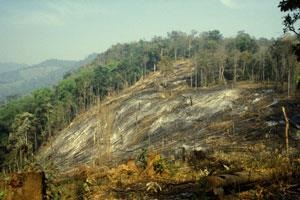
4 October 2010, Rome - The world's forest biodiversity is threatened by a high global rate of deforestation and forest degradation as well as a decline in primary forest area. In many countries, however, there is a continued positive trend towards the conservation of forest biological diversity via dedicated conservation areas.
These are some of the key findings of the final report of FAO's Global Forest Resources Assessment 2010 (FRA 2010), the most comprehensive assessment of the state of the world's forests ever undertaken. The final report of FRA 2010 was published today at the start of the latest biennial meeting of the FAO' Committee on Forestry and World Forest Week, in Rome.
Globally, around 13 million hectares (ha) of forests were converted to other uses (including agriculture) or were lost through natural causes each year between 2000 and 2010. That is down from around 16 million ha per year during the 1990s, the report said.
More than one-third of all forests are classified as primary — showing no visible signs of human intervention. Primary forests, in particular tropical moist forests, include some of the world's most species-rich and diverse ecosystems. Primary forests account for 36 percent (1.4 billion ha) of the world's forest area but their area has decreased by more than 40 million ha — at a rate of 0.4 percent annually — over the last ten years.
This does not necessarily mean that these forests have disappeared; rather, in many cases they have been reclassified because selective logging or other human interventions were carried out during the reporting period, FAO said. The UN agency emphasized that forests where humans have intervened can still hold important biodiversity values, contribute significantly to environmental protection, and sustain livelihoods, provided they are well managed.
South America accounted for the largest proportion of the loss in primary forests, followed by Africa and Asia.
Other threats to forest biodiversity include unsustainable forest management, climate change, forest fires, insect pests and diseases, natural disasters and invasive species — all of which are causing severe damage in some countries.
Better conservation and management
At the same time, the forest area designated for the conservation of biological diversity has increased by more than 95 million ha since 1990, according to FAO's report. The largest portion (46 percent) was designated between 2000 and 2005. Today 12 percent of the world's forests (more than 460 million ha) are designated primarily to conserve biological diversity.
Legally established protected areas, such as national parks, game reserves and wilderness areas now cover more than 10 percent of the total forest area in most countries and regions. The primary function of these forests may be the conservation of biological diversity, the protection of soil and water resources, or the conservation of cultural heritage.
"The world's forests represent a vital source of forest biological diversity. This biodiversity is an important treasure, especially as forests will not just have to adapt to climate change but are also expected to help mitigate it," said FAO Assistant Director-General Eduardo Rojas. "Greater investments in sustainable forest management are urgently required to better conserve and manage forest biodiversity."
FAO noted that there is an accelerating trend among countries to integrate biodiversity conservation into forest management planning and practices. However, there is a clear need for action to improve the effective conservation and sustainable use of biodiversity in production forests, particularly in forest concessions.
"Over-exploitation and unsustainable use of wildlife in many tropical regions, often from protected areas and most pronounced in Central African forests, is a major concern," Rojas said.
Wildlife at risk of extinction
FRA 2010 also warned that commercial hunting driven by consumer demand in cities will probably drive many wildlife species to extinction in the near future unless effective measures are implemented soon, including law enforcement, community participation, provision of alternative protein and the establishment of simple and practical wildlife monitoring systems.
The report contains data from 233 countries and areas covering seven themes: the extent of forest resources; biological diversity; forest health; productive; protective and socio-economic functions of forests and the legal, policy and institutional framework guiding their management and use. More than 900 experts from 178 countries contributed to the report, which is the result of a four-year effort.